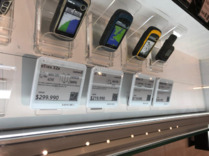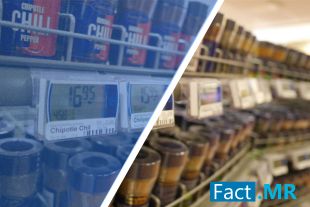In today’s fast-paced and highly competitive retail landscape, staying ahead of the curve is essential. Enter electronic shelf labels (ESLs), a cutting-edge technology that is transforming the way retailers manage pricing, inventory, and customer experience. In this post, we will explore the various benefits and applications of ESLs, and how they are reshaping the future of retail efficiency.
Enhanced Pricing Accuracy and Flexibility of Electronic Shelf Labels (ESLs)
Gone are the days of manually updating paper price tags. ESLs offer real-time pricing updates, ensuring accuracy and consistency throughout the store. Retailers can easily modify prices, launch promotions, and implement dynamic pricing strategies with just a few clicks. This flexibility not only saves time but also allows for quick response to market changes, improving competitiveness and maximizing revenue.
Improved Operational Efficiency
ESLs streamline inventory management processes, reducing human error and saving valuable staff time. With automated price updates, retailers can eliminate the need for manual price checks and price tag replacements. Real-time synchronization with the central system ensures that prices on the shelves are always up-to-date, resulting in efficient stock management and reduced pricing discrepancies.
Enhanced Customer Experience

ESLs offer a dynamic and interactive shopping experience for customers. With digital displays, retailers can showcase product information, promotions, nutritional facts, and even customer reviews. This level of detail empowers shoppers to make informed decisions, increasing customer satisfaction and loyalty. Additionally, ESLs enable retailers to implement personalized pricing or loyalty programs, enhancing the overall shopping experience and fostering customer engagement.
Optimized Store Layout and Visual Merchandising
ESLs provide retailers with valuable insights into customer behavior and product performance. By analyzing data collected from ESLs, retailers can optimize store layouts, improve product placements, and identify trends. This data-driven approach enables retailers to create visually appealing displays that capture customer attention, leading to increased sales and better overall store performance.
Sustainability and Cost Savings
ESLs contribute to a more sustainable retail environment. By eliminating the need for paper price tags, retailers can reduce paper waste and minimize their environmental footprint. Additionally, the long lifespan of ESLs reduces the need for frequent replacements, resulting in cost savings over time.
Business Trends of Electronic Shelf Labels (ESLs)
The business trends surrounding Electronic Shelf Labels (ESLs) are shaping the future of the retail industry. These trends are driven by the need for increased operational efficiency, personalized customer experiences, and data-driven decision-making.
Fact.MR foresees a thriving growth in electronic shelf label demand. The global electronic shelf label industry is expected to grow at 18.3% CAGR during 2022-2032 and surpass the value of USD 5 Billion by the end of 2032.

Let’s explore the key business trends of ESLs:
1. Adoption of IoT and Automation: ESLs are at the forefront of the Internet of Things (IoT) revolution in retail. The seamless integration of ESLs with other retail systems allows for automated price updates, inventory management, and data analytics. This integration optimizes operational efficiency and reduces manual labor.
2. Personalization and Dynamic Pricing: ESLs enable retailers to implement personalized pricing strategies based on customer data and preferences. Dynamic pricing, which adjusts prices in real time based on factors like demand and competition, is gaining momentum. This strategic approach maximizes revenue and profitability.
3. Integration with Mobile Apps and Digital Platforms: ESLs can be seamlessly integrated with mobile apps and digital platforms, providing customers with a connected shopping experience. Through these integrations, retailers can offer personalized offers, product recommendations, and real-time updates on promotions, enhancing customer engagement.
4. Enhanced Customer Engagement: Electronic Shelf Labels offer interactive displays that captivate customers with product information, reviews, and promotions. This increased interactivity not only improves the shopping experience but also influences purchasing decisions, leading to increased sales and customer loyalty.
5. Data Analytics for Insights and Decision-making: Electronic Shelf Labels generate valuable data on customer behavior, product performance, and inventory management. Retailers can leverage this data to gain insights into customer preferences, optimize store layouts, improve merchandising strategies, and make informed, data-driven decisions.
6. Sustainability and Green Initiatives: ESLs align with the growing demand for sustainability in business practices. By eliminating the need for traditional paper price tags, ESLs contribute to reducing paper waste. This eco-friendly approach showcases a commitment to sustainable operations.
7. Integration with AI and Machine Learning: Electronic Shelf Labels can be integrated with AI and machine learning algorithms to analyze customer data, predict buying patterns, and optimize pricing strategies. This integration enables retailers to offer personalized recommendations and promotions, enhancing the overall shopping experience.
8. Expansion in Various Retail Sectors: ESLs are no longer limited to grocery and food retail. Their adoption is expanding to other sectors such as electronics, fashion, and home improvement. This diversification highlights the versatility and value of ESLs in different retail environments.
As businesses strive for operational excellence, ESLs present significant opportunities for retailers to improve efficiency, engage customers, and make data-driven decisions. Embracing these business trends can give retailers a competitive edge in an ever-evolving retail landscape.
Conclusion
Electronic Shelf Labels are revolutionizing the retail industry by enhancing pricing accuracy, improving operational efficiency, and providing an enhanced shopping experience. As retailers continue to adapt to changing consumer demands, ESLs offer a competitive advantage, enabling them to stay agile, reduce costs, and deliver exceptional customer service. Embracing this innovative technology is a strategic move toward the future of retail efficiency.
- Experience the Future of Window Coverings with Smart Shades, the High-Tech Upgrade
- Smart Shoes: Revolutionary Trends & Growth of the Fitness & Footwear Industry




